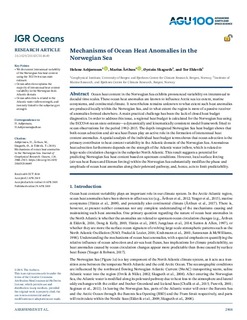| dc.contributor.author | Asbjørnsen, Helene | |
| dc.contributor.author | Årthun, Marius | |
| dc.contributor.author | Skagseth, Øystein | |
| dc.contributor.author | Eldevik, Tor | |
| dc.date.accessioned | 2019-06-18T13:29:43Z | |
| dc.date.available | 2019-06-18T13:29:43Z | |
| dc.date.created | 2019-06-05T10:23:11Z | |
| dc.date.issued | 2019 | |
| dc.identifier.citation | Journal of Geophysical Research - Oceans. 2019, 124 (4), 2908-2923. | nb_NO |
| dc.identifier.issn | 2169-9275 | |
| dc.identifier.uri | http://hdl.handle.net/11250/2601241 | |
| dc.description.abstract | Ocean heat content in the Norwegian Sea exhibits pronounced variability on interannual to decadal time scales. These ocean heat anomalies are known to influence Arctic sea ice extent, marine ecosystems, and continental climate. It nevertheless remains unknown to what extent such heat anomalies are produced locally within the Norwegian Sea, and to what extent the region is more of a passive receiver of anomalies formed elsewhere. A main practical challenge has been the lack of closed heat budget diagnostics. In order to address this issue, a regional heat budget is calculated for the Norwegian Sea using the ECCOv4 ocean state estimate—a dynamically and kinematically consistent model framework fitted to ocean observations for the period 1992–2015. The depth‐integrated Norwegian Sea heat budget shows that both ocean advection and air‐sea heat fluxes play an active role in the formation of interannual heat content anomalies. A spatial analysis of the individual heat budget terms shows that ocean advection is the primary contributor to heat content variability in the Atlantic domain of the Norwegian Sea. Anomalous heat advection furthermore depends on the strength of the Atlantic water inflow, which is related to large‐scale circulation changes in the subpolar North Atlantic. This result suggests a potential for predicting Norwegian Sea heat content based on upstream conditions. However, local surface forcing (air‐sea heat fluxes and Ekman forcing) within the Norwegian Sea substantially modifies the phase and amplitude of ocean heat anomalies along their poleward pathway, and, hence, acts to limit predictability. | nb_NO |
| dc.language.iso | eng | nb_NO |
| dc.title | Mechanisms of Ocean Heat Anomalies in the Norwegian Sea | nb_NO |
| dc.type | Journal article | nb_NO |
| dc.type | Peer reviewed | nb_NO |
| dc.description.version | publishedVersion | nb_NO |
| dc.source.pagenumber | 2908-2923 | nb_NO |
| dc.source.volume | 124 | nb_NO |
| dc.source.journal | Journal of Geophysical Research - Oceans | nb_NO |
| dc.source.issue | 4 | nb_NO |
| dc.identifier.doi | 10.1029/2018JC014649 | |
| dc.identifier.cristin | 1702862 | |
| dc.relation.project | Norges forskningsråd: 263223 | nb_NO |
| dc.relation.project | Trond Mohn stiftelse: BFS2018TMT01 | nb_NO |
| dc.relation.project | EC/H2020/727852 | nb_NO |
| cristin.unitcode | 7431,20,0,0 | |
| cristin.unitname | Oseanografi og klima | |
| cristin.ispublished | true | |
| cristin.fulltext | original | |
| cristin.qualitycode | 2 | |
